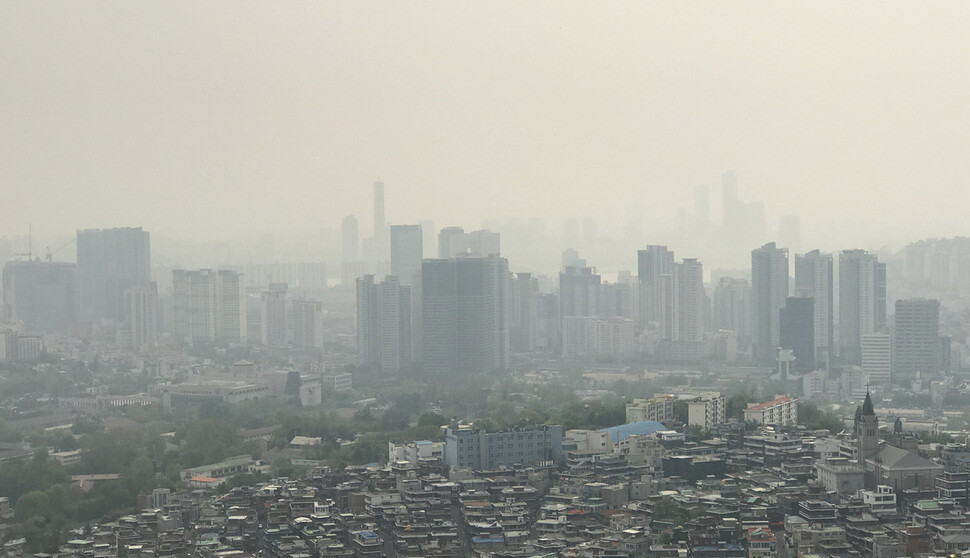hankyoreh
Links to other country sites 다른 나라 사이트 링크
New findings show PM bacteria similarities in the air above Korea, China, and Japan

New research finds that 83% of the bacteria found in fine particulate matter (PM) in China and Korea are the same, suggesting that the fine dust blowing from China to Korea may contain the organisms.
On August 28, a research team consisting of professors Kim Ho, Lee Jae-young and Lee Seung-mook from the Graduate School of Public Health at Seoul National University (SNU) published their findings after conducting analysis on floating microorganisms in fine dust samples taken from Seoul, Beijing and Nagasaki. The similarity between bacteria found in the air in Seoul and Beijing was 83%, while the figure for Seoul and Nagasaki was 73%. Proteobacteria, firmicutes and actinobacteria, which have all been found inside humans, accounted for 67.3% of the bacteria in fine dust in all three cities.
The researchers took samples of fine dust from the rooftops of Seoul National University, Peking University and Nagasaki University over the course of a year and then extracted genetic material from the bacteria for analysis at SNU. The team found that the highest degree of similarity between bacteria during winter and spring, while the figure was lowest in summer. They believe that this is due to strong north-westerly winds coming from Siberia during winter and spring.
“These results are significant because they confirm the diversity and level of similarity between fine particulate matter in three major East Asian cities,” the researchers said. “However, from a meteorological perspective, the fact that these bacteria can float does not necessarily mean that they blew over from China to Korea and Japan, and further research is needed on this point.”
The research was published in the latest issue of Nature, as well as its sister publication Scientific Reports.
By Kim Yang-joong, medical correspondent
Please direct questions or comments to [english@hani.co.kr]

Editorial・opinion
![[Editorial] Japan’s rewriting of history with Korea has gone too far [Editorial] Japan’s rewriting of history with Korea has gone too far](https://flexible.img.hani.co.kr/flexible/normal/500/300/imgdb/original/2024/0422/1717137715201877.jpg) [Editorial] Japan’s rewriting of history with Korea has gone too far
[Editorial] Japan’s rewriting of history with Korea has gone too far![[Column] The president’s questionable capacity for dialogue [Column] The president’s questionable capacity for dialogue](https://flexible.img.hani.co.kr/flexible/normal/500/300/imgdb/original/2024/0422/1517137717613239.jpg) [Column] The president’s questionable capacity for dialogue
[Column] The president’s questionable capacity for dialogue- [Column] Are chaebol firms just pizza pies for families to divvy up as they please?
- [Column] Has Korea, too, crossed the Rubicon on China?
- [Correspondent’s column] In Japan’s alliance with US, echoes of its past alliances with UK
- [Editorial] Does Yoon think the Korean public is wrong?
- [Editorial] As it bolsters its alliance with US, Japan must be accountable for past
- [Guest essay] Amending the Constitution is Yoon’s key to leaving office in public’s good graces
- [Editorial] 10 years on, lessons of Sewol tragedy must never be forgotten
- [Column] A death blow to Korea’s prosecutor politics
Most viewed articles
- 1Korean government’s compromise plan for medical reform swiftly rejected by doctors
- 2[Column] The president’s questionable capacity for dialogue
- 3[Editorial] Japan’s rewriting of history with Korea has gone too far
- 4Samsung barricades office as unionized workers strike for better conditions
- 5[Reporter’s notebook] Did playing favorites with US, Japan fail to earn Yoon a G7 summit invite?
- 6[Column] The clock is ticking for Korea’s first lady
- 7Korea protests Japanese PM’s offering at war-linked Yasukuni Shrine
- 8All eyes on Xiaomi after it pulls off EV that Apple couldn’t
- 9[Column] Are chaebol firms just pizza pies for families to divvy up as they please?
- 10What Israel’s ‘warning shot’ response to Iran means for Middle East tensions